Brief
With many US property and casualty (P&C) insurers stuck in a growth quagmire, retaining and attracting good customers has become critical to success. Over the previous five years, the industry’s return on equity has fallen below the cost of capital, and net premium growth is at a historic low.
There’s a way out of the quagmire—namely, a sustained program to earn customer loyalty. Customers who are promoters of their insurers stay longer, recommend the company to friends and family, and usually cost less to serve. All of those traits can be quantified. At one major US P&C insurer, for example, we estimate that a promoter’s lifetime value is worth, on average, more than twice that of a passive customer and about five times that of a detractor. For this particular insurer, the higher value comes mostly through longer retention, plus a boost from cross-selling and referrals (see Figure 1).
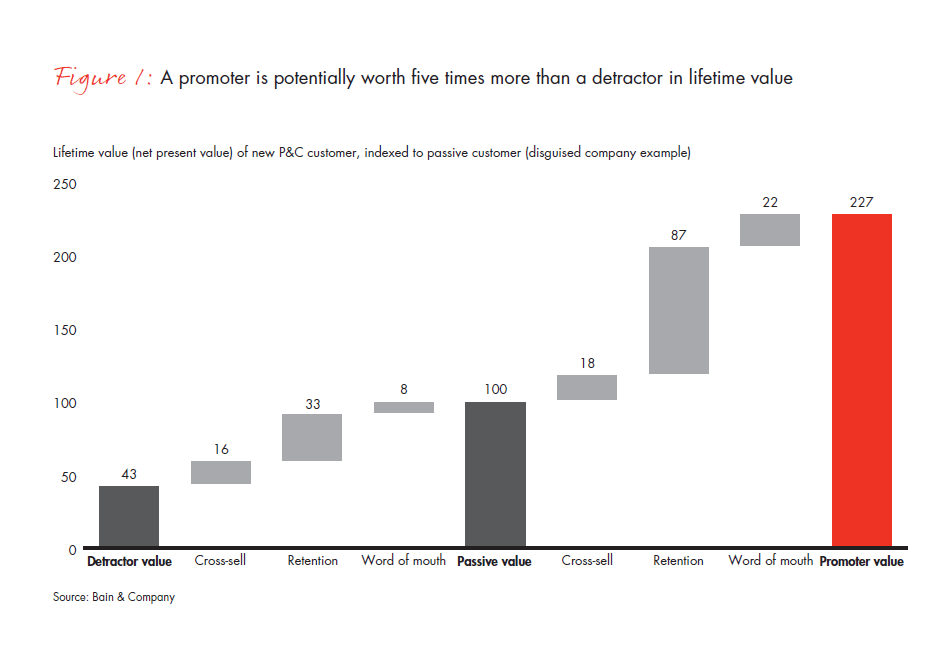
Loyalty, in short, can improve the economics of the business.
But raising the level of loyalty is not a simple task. The ease of comparison shopping online, combined with a price-focused advertising arms race, has led more customers to initially choose a provider based primarily on price. And highly price-sensitive customers may be more likely to switch for price down the road. Rich incentives might work to gain market share, but often the winner winds up overpaying for the segment of consumers who use price to game the system.
We would argue that investing money and resources to improve one’s value proposition and customer experience is essential for recouping the investment laid out to acquire those customers in the first place. Indeed, price is far from the only consideration for customers. When Bain & Company recently surveyed about 166,000 US consumers with home or auto policies, respondents who had positive comments about their insurers valued service slightly more than price, followed by the company’s reputation, product features and other factors.
Companies that are able to sustain high levels of advocacy use regular customer feedback to understand what they are doing right and what they are doing wrong. They loop the feedback quickly to frontline employees and their managers, which allows employees to discover the root causes of problem areas and then take targeted actions to improve customers’ experience.
A customer-centered business system, such as the Net Promoter SystemSM, gives insurers one framework that can be applied across all channels and customer segments. That system forms the foundation for determining which investments will yield the highest return and for structuring initiatives that will improve the customer experience in the highest-priority areas.
Where should insurers invest to raise loyalty? Insurance loyalty leaders are placing their bets on three areas:
- A “wow” claims process. It should come as no surprise to insurers that handling a claim is one of those hinge moments that can turn neutral customers into staunch promoters or detractors. Yet ample opportunities remain. Investing to improve the speed of compensation, the ease of filing and the quality of interactions with claims representatives can yield big returns.
- Stronger secondary channels. Historically, most P&C insurers have grown their businesses primarily through one dominant channel. In recent years, insurers have been expanding their secondary channels; for example, Geico is adding agents, while Allstate and State Farm are bolstering their online channel capabilities. But for most insurers, the secondary channels consistently disappoint consumers, leaving insurers vulnerable. An insurer is only as good as the last interaction with the customer, and if that happens to be a bad online experience at an agent-focused company, it does not matter how good the agent experience is— loyalty will erode.
- A great customer experience at a select few moments of truth. Certain interactions such as modifying a policy also have the potential to delight or annoy customers. Improving to top-quartile performance in these activities will yield further gains.
Let’s look at each area from the perspective of those who matter most—the customers.
What consumers are saying about their insurance companies
Bain’s survey of US insurance consumers found that their Net Promoter ScoreSM (NPS®) rose in 2012 over 2011 for the 15 companies represented. However, there is substantial variation in scores and almost no change in relative position over the year. The top quartile of insurers achieved an NPS of 45, almost double that of the average insurer at 24 (see Figure 2). Year after year, a few companies, such as USAA, have remained loyalty leaders.
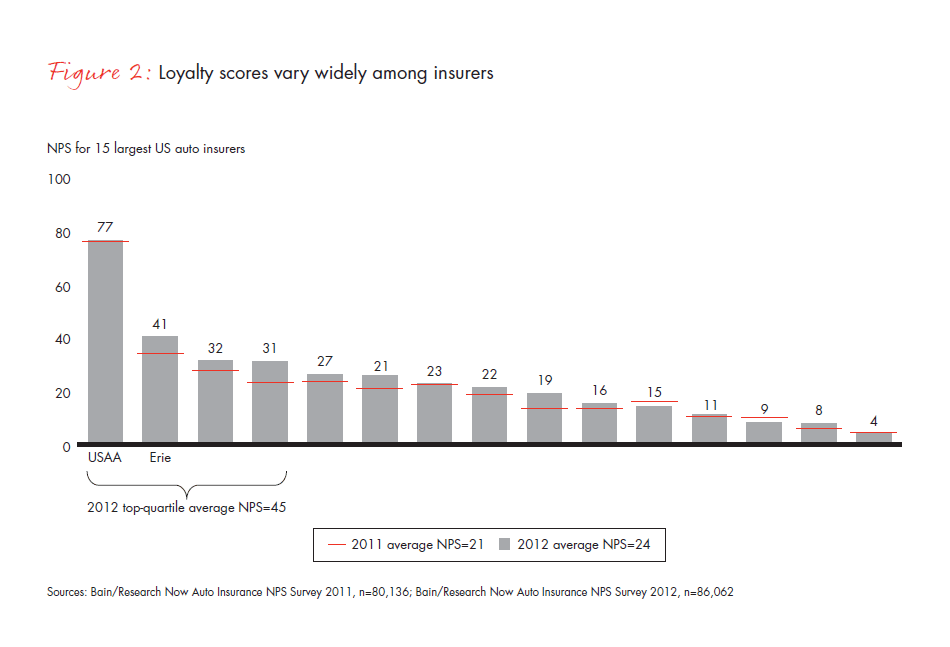
Two other findings, concerning channels and claims, are highly relevant. First, a greater appreciation of an insurer’s service comes after an accident or problem that triggers a claim. NPS is 12 points higher, on average, for customers who have recently submitted a claim, relative to nonclaimants (see Figure 3). Claims handling clearly provides another major opportunity to raise loyalty.
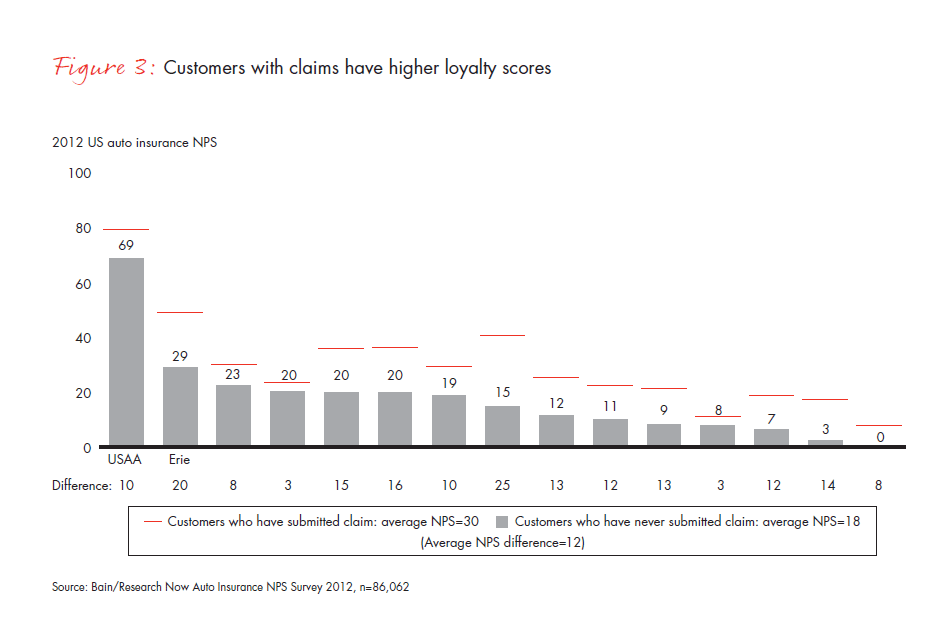
Second, for most P&C insurers, the base of promoters was built on an agency relationship; for direct models, the base was built through phone agents or online. Either way, a great majority of insurers have much higher loyalty scores in their dominant channels—to the tune of an average 18 points higher (see Figure 4). This suggests a major opportunity for insurers to improve their customers’ experience in secondary channels.
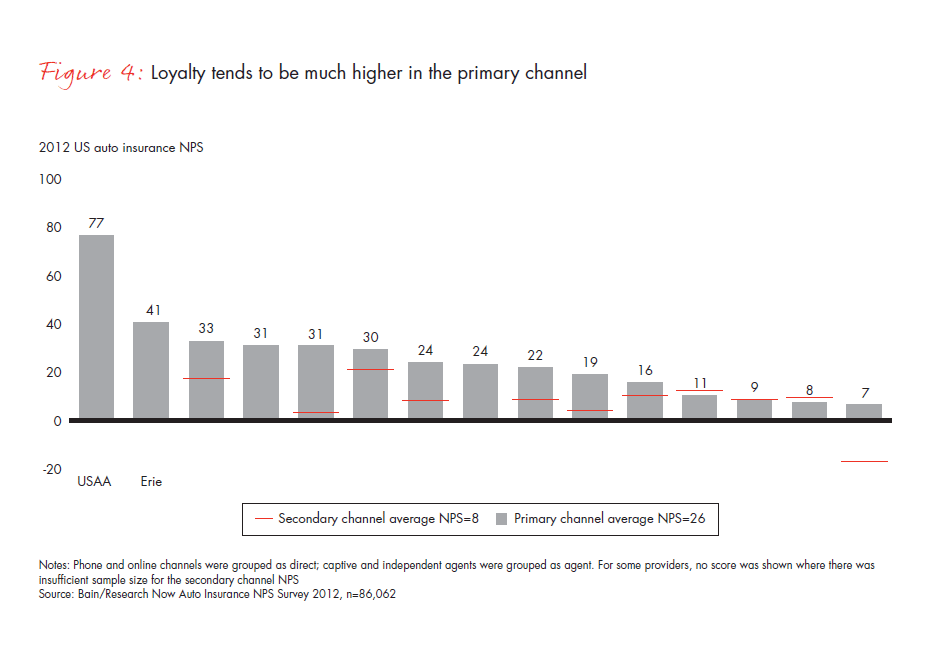
How advocacy affects economics
The higher lifetime value of promoters comes mostly through longer retention (see Figure 1)—in auto coverage, some 44% of all promoters have been with their insurance company longer than 6 years, compared with just 27% of detractors. Retention of customers is typically the most important factor in an industry where customers have a regular purchase decision triggered by the renewal of a contract and where advertising encourages consumers to shop around. There’s also a boost from promoter word-of-mouth, referring new customers to an insurer. Cross-selling may offer some upside, but it depends on the breadth of products the insurer offers as well as the insurer’s current share of spending among current customers.
Top-quartile performers have far more promoters among their customers and far fewer detractors. As a result, their 21-point advantage in NPS, relative to average performers, translates to a 13% improvement in average customer lifetime value (see Figure 5).
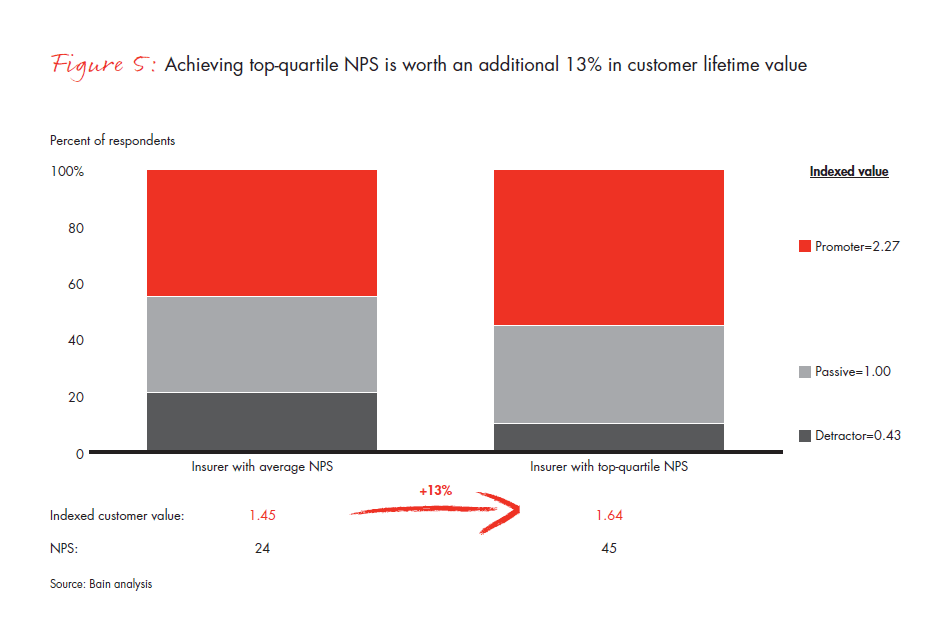
Put another way, an improvement of this magnitude is comparable to a 2 to 4 percentage-point improvement in combined ratio. The actual benefit would depend on an individual insurer’s underwriting and investment performance. And loyalty score improvements won’t necessarily show up in the combined ratio; they might appear as improvements to the top line. Still, 2 to 4 points of combined ratio is well worth a sustained initiative.
What insurers can do to earn advocacy
Earning loyalty entails a balancing act. Most employees naturally want to delight customers and feel great when they do so. But for the enterprise to thrive, they have to generate loyalty in economically rational ways.
To delight customers by making their lives more convenient, while also fortifying the bottom line, insurers should keep several principles in mind.
Understand which are the moments of truth and how one can measure them. There are several layers to understand, such as where the most important interactions are occurring and where the problems are. Getting a detailed picture involves de-averaging current NPS.
At some insurers, for customers filing a claim, the most important moments include learning what will be the level of compensation and the extent of coverage for the incident in question, as well as interacting with the claims adjuster (see Figure 6). For people who have not filed a claim, the most important moments include getting a quote, modifying a policy and determining what products are available.
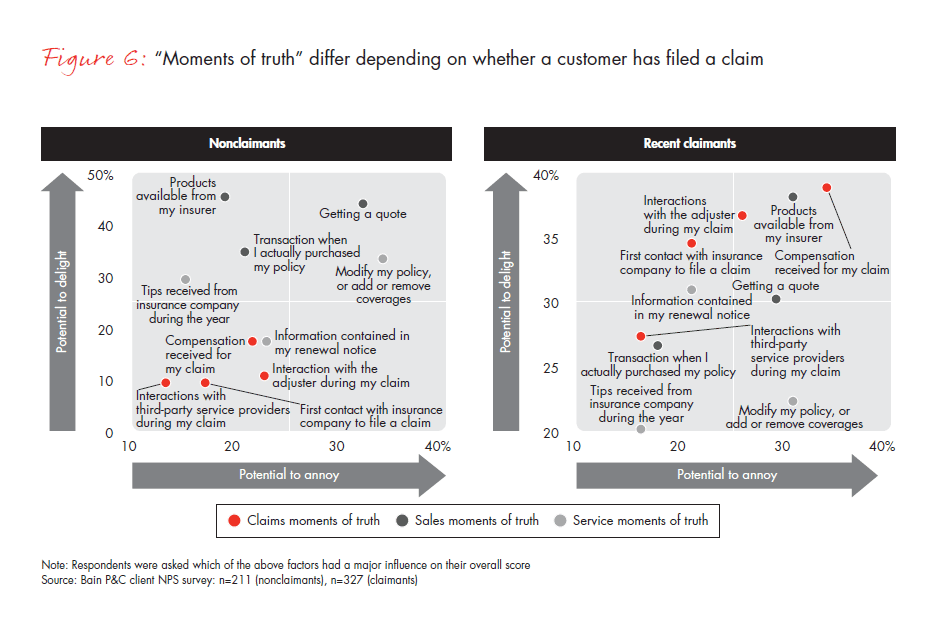
An insurer will also want to understand how it is acquiring new customers. Those customers who are extremely price sensitive and come in through a website, for example, may be inherently less loyal than customers who come in through a friend’s recommendation.
Obtaining a richly detailed picture of key moments and the composition of the customer base takes a dedicated effort. It requires use of the Net Promoter System or a similar system that includes these components:
- A reliable metric for segmenting customers into degrees of loyalty and gaining an understanding of the company’s competitive position
- Calculations and analysis that provide a true understanding of the costs and benefits of investing in different segments of the customer base to earn more of customers’ loyalty
- Root-cause analysis that mines customer feedback and other sources of data for deeper insights into what one can do to create more promoters and fewer detractors
- A closed loop that sends customer feedback quickly and frequently to employees and responds directly to individual customers to take action on their concerns
- Test-and-learn processes to help employees experiment and get the coaching they need
- Robust operational infrastructure so that loyalty becomes part of the everyday work, not just research
Invest in a consistent “omnichannel” experience. US insurance customers want to be able to use the channel convenient to the moment, whether that’s a website, call center, a meeting or a video chat with an agent.
Success thus requires insurers to develop an approach that engages customers seamlessly across all channels. Each channel should have the same customer information available to employees, and the insurer can motivate customers to use the most appropriate channel for a given activity, such as being able to go online to add someone to a policy, rather than needing to talk with an agent.
Over the next few years, acquiring new customers and interacting with existing customers will increasingly cut across different channels. The ratio of traditional to new channel usage, currently around 90–10, is likely to shift over the next decade.
If an insurer focuses its loyalty efforts only on the dominant channel, the shift in channel mix could cause NPS to deteriorate, making it more expensive to acquire and retain customers. For an insurer that starts with a traditional-to-new channel mix of 90–10, assuming that the company migrated its channel mix to 60–40 but did nothing else, NPS would decline 6 points to 18 (see Figure 7). In contrast, if the insurer took steps to raise loyalty in the secondary channel to a level matching that of its primary channel, NPS would rise a couple of points. Because of the differences in loyalty from one channel to another, insurers will have to adjust their loyalty initiatives as the mix of channels evolves.
Aim for best-in-class claims processing. Given how much customers value superior handling of a claim, this area presents an opportunity for earning loyalty through any channel. Achieving top-quartile claims performance delivers an average 5-point improvement in NPS across the customer base (see Figure 7).
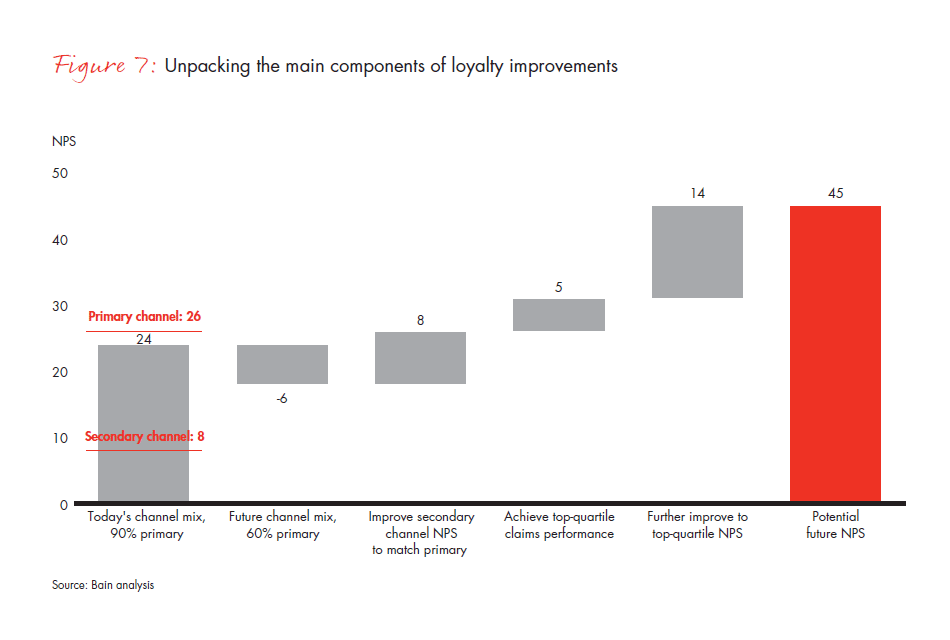
Tokio Marine’s highly automated system means that claims processing, which used to take more than three days, now can be handled in real time. Information on repair cost, repair status and expected time for completion is swiftly provided to customers, and more than half of the company’s auto claims are paid out within five days.
Similarly, USAA has rolled out a software program that partially automates the task of estimating the value of contents in a customer’s house, using location and demographic data. This technology is one reason that USAA now can cut a home-related claims check in a day or two.
Both initiatives illustrate how digital technologies paired with the right processes can create a superior experience for customers.
Invest selectively, and in a coordinated manner, in other moments of truth. Besides claims processing, further improvements in other aspects of the customer experience, to achieve top-quartile performance, are worth a 14-point increase in NPS (see Figure 7). These include the moments of truth mentioned earlier: getting a quote, modifying a policy and determining what products are available.
With a strong understanding of the customer base in place, an insurer can proceed with selective investments in technologies or activities that will delight customers at these key moments, and dial back or stop nonessential investments.
Progressive, for instance, has used customer feedback to inform investments and decisions in setting up recurring electronic funds transfers and in developing clearer customer communications about renewal quotes and discounts.
Financial services firm Charles Schwab has used the insights from NPS to invest in world-class call centers. Schwab eliminated average handle time as the sole metric for assessing its phone representatives, raised the importance of first-call resolution and gave representatives greater authority over items such as fee waivers. It matched each qualifying customer who lives far from a branch with a dedicated representative. And it appointed a high-performing branch manager to collect and disseminate loyalty-related best practices across the branches and call centers. In broad strokes, Schwab now considers its call centers to be a competitive advantage instead of an expense.
Opportunities abound as well to create new touchpoints or make the brand or the value proposition more distinctive. One insurer was regularly getting feedback from customers that the process of buying a car and haggling over price caused a lot of anxiety. The company created a car-buying service that helps shop for a car, provides detailed price information and ultimately saves customers thousands of dollars on their car purchase. The service, which can also be used via smartphones, guarantees that it will find the lowest price option—or pay the difference if the buyer finds a lower price elsewhere.
Such innovations convey that “we’ve got your back” and further cement loyalty. They emerge only by thinking about customers’ priorities at different stages of life, as distinct from taking an actuarial perspective.
Coordination across the organization is essential here. At many large, old-line insurers, underwriting and claims and finance each makes its own investment decisions, which obstructs the goal of having a unified view of the customer. Another common problem involves spending heavily on IT systems but underinvesting in mechanisms to measure customer interactions and provide rapid feedback, or in recruiting talent with new skills. Isolated, uncoordinated investments create major inefficiencies. Incorporating customers’ priorities into key investment decisions is the first step toward designing a customer-centered insurance organization.
Conscious of these issues, one regional P&C insurer has been careful to coordinate its investments in policy offerings and claims management. It has provided independent agents with tools to tailor policies and terms to specific customer segments and developed technology that allows agents and customers to track claims progress and interact with each other on their mobile devices. Notably, these investments actively involved not just the IT group, but also teams from underwriting, claims, pricing and other parts of the organization. Both initiatives have made substantial contributions to the company’s improvements in loyalty scores.
The path to organic growth in P&C insurance obviously involves a number of factors, including a sustained cost advantage (especially for simple, low-priced products), sophisticated risk analytics, innovative products and targeted marketing.
But sustainable growth also hinges on creating a superior customer experience, integrated seamlessly across all channels. Having a regular, simple and disciplined score and feedback system gives management a clear view of the company’s loyalty position and a rigorous means of assessing which investments will improve the customer experience while producing the greatest financial benefits.
Steven Kauderer, Sean O’Neill and David Whelan are partners in Bain & Company’s Global Financial Services practice.






